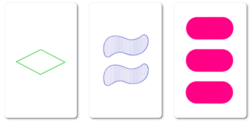Set (card game)
- Set! redirects here. Set! is also a special form in the Scheme programming language.
| Type | Real time |
|---|---|
| Players | 1+ |
| Skills | Visualization, logical reasoning, ability to focus |
| Cards | 81 |
| Playing time | 10-30 minutes [citation needed] |

Set is a real-time card game designed by Marsha Falco in 1974 and published by Set Enterprises in 1991. The deck consists of 81 cards varying in four features: number (one, two, or three); symbol (diamond, squiggle, oval); shading (solid, striped, or open); and color (red, green, or purple).[1] Each possible combination of features (e.g., a card with three striped green diamonds) appears precisely once in the deck.
History
The game evolved out of a coding system that the designer used in her job as a geneticist.[2] Set won American Mensa's Mensa Select award in 1991 and placed 9th in the 1995 Deutscher Spiele Preis.
Games

Several games can be played with these cards, all involving the concept of a set. A set consists of three cards which satisfy all of these conditions:
- They all have the same number, or they have three different numbers.
- They all have the same symbol, or they have three different symbols.
- They all have the same shading, or they have three different shadings.
- They all have the same color, or they have three different colors.
The rules of Set are summarized by: If you can sort a group of three cards into "Two of ____ and one of _____," then it is not a set.
For example, these three cards form a set:
- One red striped diamond
- Two red solid diamonds
- Three red open diamonds
Given any two cards from the deck, there is one and only one other card that forms a set with them.
In the standard Set game, the dealer lays out cards on the table until either twelve are laid down or someone sees a set and calls "Set!" The player who called "Set" takes the cards in the set and the dealer continues to deal out cards until twelve are on the table. A player who sees a set among the twelve cards calls "Set" and takes the three cards, and the dealer lays three more cards on the table. (To call out "set" and not pick one up quickly enough results in a penalty.) It is possible that there is no set among the twelve cards; in this case, the dealer deals out three more cards to make fifteen dealt cards, or eighteen or more, as necessary. This process of dealing by threes and finding sets continues until the deck is exhausted and there are no more sets on the table. At this point, whoever has collected the most sets wins.
Variants were included with the Set game that involve different mechanics to find sets as well as different player interaction. Additional variants continue to be created by avid players of the game.[3][4]
Basic combinatorics of Set
- Given any two cards, there is exactly one card which forms a set with those two cards. Therefore, the probability of producing a Set from 3 randomly drawn cards from a complete deck is 1/79.
- The largest group of cards you can put together without creating a set is 20.[5] Such a group is called a maximal cap (sequence A090245 in the OEIS).
- There are unique sets.
- The probability a set will have features different and features the same is (Note: The case where d=0 is impossible since no two cards are identical). Thus, 10% of possible sets differ in one feature, 30% in two features, 40% in three features, and 20% in all four features.
- The number of different 12-card deals is
- The odds of getting at least one Set when dealing three consecutive cards during a game are
- The odds against there being no Set in 12 cards when playing a game of Set start off at 30:1 for the first round. Then they quickly fall, and after about the 4th round they are 14:1 and for the next 20 rounds they slowly fall towards 13:1. So for most of the rounds played, the odds are between 14:1 and 13:1.[6]
- The odds against there being no Set in 15 cards when playing a game are 88:1.[6] (This is different from the odds against there being no Set in any 15 cards (which is 2700:1), since during play, 15 cards are only shown when a group of 12 cards have no Set.)
- Around 30% of all games always have a Set among the 12 cards, and thus never need to go to 15 cards.[6]
- The average number of available Sets among 12 cards is and among 15 cards .
References
- ^ "How to Play Set".
- ^ http://www.setgame.com/set/history.htm
- ^ http://magliery.com/Set/SetVariants.html
- ^ http://www.thegamesjournal.com/rules/GetSet.shtml
- ^ Benjamin Lent Davis and Diane MacLagan. "The Card Game Set" (PDF). Archived from the original (PDF) on June 5, 2013.
{{cite web}}: Unknown parameter|deadurl=ignored (|url-status=suggested) (help) - ^ a b c "SET Probabilities Revisited".
External links
- Set Enterprises website
- A (2002?) mathematic exploration of the game Set . Including 'How many cards may be laid without creating a set', as well as investigations of different types of set games (some in the Fano plane).
- The Mathematics of the Card Game Set - Paola Y. Reyes - 2014 - Rhode Island College Honors Projects
- Set at BoardGameGeek
- There is a graphic computer solitaire version of Set written in tcl/Tk. The script can be found in a "tclapps" bundle at ActiveState Ftp://tcl.activestate.com/pub/tcl/nightly-cvs/ .
- Sets, Planets, and Comets. An alternate, extended version of Set
- Set Daily Puzzle








